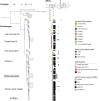Genomic epidemiology of Shigella in the United Kingdom shows transmission of pathogen sublineages and determinants of antimicrobial resistance
- PMID: 29743642
- PMCID: PMC5943296
- DOI: 10.1038/s41598-018-25764-3
Genomic epidemiology of Shigella in the United Kingdom shows transmission of pathogen sublineages and determinants of antimicrobial resistance
Abstract
Shigella are globally important diarrhoeal pathogens that are endemic in low-to-middle income nations and also occur in high income nations, typically in travellers or community-based risk-groups. Shigella phylogenetics reveals population structures that are more reliable than those built with traditional typing methods, and has identified sublineages associated with specific geographical regions or patient groups. Genomic analyses reveal temporal increases in Shigella antimicrobial resistance (AMR) gene content, which is frequently encoded on mobile genetic elements. Here, we whole genome sequenced representative subsamples of S. flexneri 2a and S. sonnei (n = 366) from the United Kingdom from 2008 to 2014, and analysed these alongside publicly available data to make qualitative insights on the genomic epidemiology of shigellosis and its AMR within the broader global context. Combined phylogenetic, epidemiological and genomic anlayses revealed the presence of domestically-circulating sublineages in patient risk-groups and the importation of travel-related sublineages from both Africa and Asia, including ciprofloxacin-resistant sublineages of both species from Asia. Genomic analyses revealed common AMR determinants among travel-related and domestically-acquired isolates, and the evolution of mutations associated with reduced quinolone susceptibility in domestically-circulating sublineages. Collectively, this study provides unprecedented insights on the contribution and mobility of endemic and travel-imported sublineages and AMR determinants responsible for disease in a high-income nation.
Conflict of interest statement
The authors declare no competing interests.
Figures



References
-
- Dritz SK, Back AF. Letter: Shigella enteritis venereally transmitted. The New England journal of medicine. 1974;291:1194. - PubMed
-
- Borg, M. L. et al. Ongoing outbreak of Shigella flexneri serotype 3a in men who have sex with men in England and Wales, data from 2009–2011. Euro surveillance: bulletin europeen sur les maladies transmissibles = European communicable disease bulletin17 (2012). - PubMed
Publication types
MeSH terms
Substances
Grants and funding
LinkOut - more resources
Full Text Sources
Other Literature Sources
Medical

